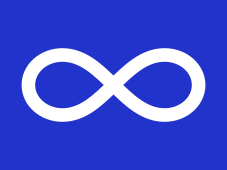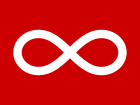Métis flag facts for kids
 |
|
| Use | Blue version |
|---|---|
| Adopted | 1816 |
| Design | Infinity symbol on a blue background |

Variant flag of Métis flag
|
|
| Use | Red version |
| Adopted | 1815 |
| Design | Infinity symbol on a red background |
The Métis flag is a very old and important symbol for the Métis people. It was first used by Métis fighters in a place called Rupert's Land even before a big event known as the Battle of Seven Oaks in 1816. Some stories say the flag was a gift from the North West Company in 1815, but this isn't fully confirmed by other historical records. Both red and blue versions of this flag have been used to show the strength and spirit of the Métis people for a very long time. This flag is even older than the current Flag of Canada by about 150 years! It's the oldest patriotic flag created by Indigenous people in Canada.
Today, the blue Métis flag is the official flag of the Métis Nation, recognized by the Métis National Council. In 2013, they made sure the flag was protected as a special symbol for all Métis citizens. This helps ensure it belongs to everyone in the Métis Nation.
Contents
How the Métis Flag Became Official
For a while, the original Métis flag was not widely used. Other flags were flown as the Métis Nation grew. In the 1970s, a different flag with a green background, shamrocks, fleur-de-lys, and a bison was sometimes used.
But there were disagreements about which flag truly represented Métis history. This led to a search for the original flag. Experts were asked to research old Métis flags. After much discussion, the blue infinity flag was chosen by the Métis Society of Saskatchewan. Later, both the red and blue versions were adopted by other Métis governments in Western Canada.
What Does the Métis Flag Look Like?
The Métis flag has a white infinity symbol on a background that is either blue or red. People have many ideas about what this symbol and these colors mean.
Meanings of the Infinity Symbol
- It can mean that Métis culture will last forever.
- It might show the joining of European and First Nations peoples. The two loops represent two cultures becoming one.
- Some think it's like the ouroboros, an old symbol of a snake eating its tail, which means new beginnings.
- It could also be linked to traditional Métis and French Canadian dances, where dancers move in a figure-eight shape.
- Some see a connection to Celtic designs and Scottish traditions, like Celtic knots or dances.
- Another idea is that it comes from Plains Indian Sign Language for Métis. This might be related to the Red River cart used by the Métis.
Meanings of the Flag Colors
There are different ideas about what the red and blue colors of the Métis flag represent.
- Some believe red stands for the Hudson's Bay Company and blue for the North West Company. However, both companies actually used red flags.
- Others say blue is for French-speaking Métis and red for English-speaking Métis.
- Some think the blue and white colors come from the Flag of Scotland and the traditional colors of Quebec.
- There's also a thought that red was for Métis in Manitoba and the Northwest, and blue for Saskatchewan Métis.
- Another idea is that the color depended on its use. The red flag might have been a 'Hunting Flag' to show they were on a bison hunt, not going to war. It could also have been a battle flag during hunts where fights might happen, like the Battle of Grand Coteau.
- Some have also suggested that the flag was simply a design idea that was tried out. This explains why both red and blue versions exist with the same white infinity symbol.
It's hard to know the exact history because there are no clear written records from when the flag was first made.
Different Ideas About the Flag's Colors
A well-known Métis historian, Jean Teillet, suggests that some stories about the flag's origin might not be entirely accurate. She points out that only one early account mentioned the flag as a gift from the North West Company, and this was based on rumors. She believes the Métis people likely created the flag themselves.
She also suggests that the colors (red or blue) might have been chosen simply because those were the fabric colors available at trading posts at the time. It might have been a practical choice, not a political one.
The Flag's Story: Early Days
In the early days, other flags like those of the Hudson's Bay Company flag and North West Company flag, and the Union Jack, were seen in Rupert's Land. Métis oral traditions say that the Métis created the infinity flag themselves, calling it Li Paviiyoon di Michif. Some stories suggest Alexander Macdonell of Greenfield gave a flag to the Métis in 1814, helping to create the Métis Nation, but this isn't fully confirmed.
Who First Saw the Métis Flag?
The Métis flag was first mentioned in writing by James Sutherland in 1815. He saw a red flag with an infinity symbol being flown by Cuthbert Grant in the Qu'Appelle area. Sutherland heard a rumor that the flag was a gift from the North West Company. However, he didn't have direct proof, and he heard this story from others.
Sutherland saw the flag again in early 1816 when John McDonald arrived from Swan River. He also wrote about why people said the flag was flying. Sutherland wrote his accounts from memory later, as he had destroyed his original papers.
Other Early Sightings of the Flag
Peter Fidler also saw a red Métis flag with an infinity symbol around March 1816, near the Qu'Appelle River. He noted it had been seen the previous fall. Fidler heard rumors about the North West Company encouraging Métis actions, but he didn't say the flag was a gift.
On June 1, 1816, Fidler wrote in his journal that Métis fighters, led by Cuthbert Grant, flew a blue flag with an infinity symbol. This was during an attack on Brandon House, just before the Battle of Seven Oaks. It's not known why the flag's color changed from red to blue. Fidler did not provide details about where the flag came from.
Other Flags Used by the Métis People
Legislative Assembly of Assiniboia
The first Métis government, called the Legislative Assembly of Assiniboia, was set up by Louis Riel in 1869. They flew a flag that has been described in many ways. Some descriptions include a fleur-de-lis and a shamrock on a white background. Others mention a bison, or a combination of these symbols.
Provisional Government of Saskatchewan
Louis Riel also set up a temporary government in Batoche in 1885. They used at least two flags. One was described as a white flag with a large image of Mary's immaculate heart. Riel also had a personal banner with images and poems. During the Battle of Batoche, a flag of the Blessed Virgin was flown on one house, and another flag of Our Lord was on the Council's house.
There is also a claim about a Métis Battle Standard used at the Battle of Batoche. It is described as a blue flag with a wolf's head and a hand in the middle. It also had the Michif words "maisons ... autels ... Surtout Liberté" (meaning "homes, altars, above all liberty"). This flag was said to be made by Métis women to encourage the men in battle. However, the earliest known picture of this flag is from 1975.
See also
- Métis buffalo hunt
- Métis in Canada
- Métis in the United States
- Métis in Manitoba

